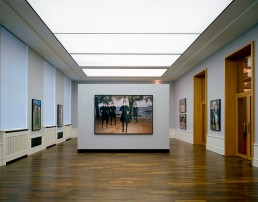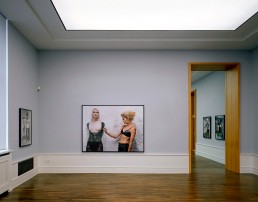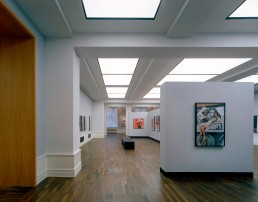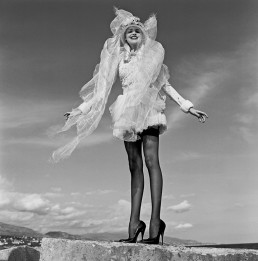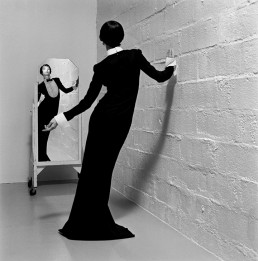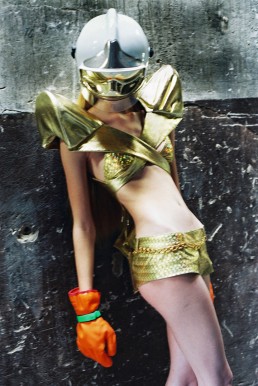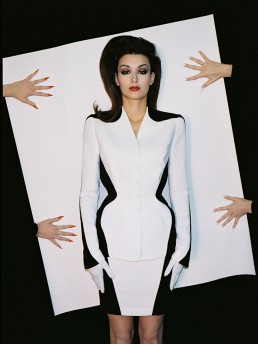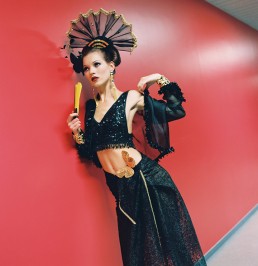I believe that the perfect fashion photo doesn´t look like a fashion photo; it looks more like a photo from a film, a portrait, or a photo taken to preserve a memory—somehow but not like a fashion photo. (Helmut Newton)
A gun for hire is how Helmut Newton sometimes used to describe himself – as someone commissioned by fashion labels, bathtub manufacturers, or hardware store chains to photograph their products. But many of the unconventional images he created in this role revolutionized fashion and product photography. Over 100 such photographs from the past two decades – not previously shown in a museum context – are now being presented at the Helmut Newton Foundation under the title A Gun for Hire. These include fashion photographs for Chanel, Yves Saint Laurent, Versace, Blumarine, and Mugler, along with photo editorials for various country editions of Vogue, as well as commissions for other clients. Helmut Newton began working for French Vogue in 1961. According to the photographer, “Throughout the sixties, I did my best to sell them the most sexually suggestive fashion photos.”
As a photographer working between commerce and art, Helmut Newton succeeded in both surprising and polarizing viewers. In many of the magazine editorial offices he found fellow creative minds who welcomed his unorthodox visual concepts. The result was an extraordinarily unique and successful body of work that reached an audience of millions through magazine distribution. It’s impossible to pin Helmut Newton down as a photographer of only fashion, only nudes, or only portraits. Spanning five decades, his work encompasses multiple genres and resists categorization; the photographer surprised his clients, his team, and perhaps even himself again and again. His fashion images underscore the styles of individual fashion labels, for example the traditionally classic look of Chanel, but for the most part they remain a step ahead of the trend. It is particularly interesting to compare the settings and compositions he used for the various labels, which required distinct accessories, backdrops, and their own visual language.
Helmut Newton owed his unparalleled success to the world of commerce, as he once stated – not to foundations or museums. He always viewed his work for magazines and other clients as a source of inspiration, and the editorial pages of fashion magazines as “a kind of laboratory,” in which he could consistently “try out new ideas.” Thus he always avoided producing photos that would “end up in a drawer”; instead, he achieved his goal of “having as many people as possible see them.” The framework set by the client and the available budget were the cornerstones of his commercial photography, which also enabled him to realize other projects.
Helmut Newton always emphasized how much he was fascinated by strong women. In one of his last photographs, produced for an editorial in the American Vogue, he gives us a particularly striking example: a lean, scantily clad woman stands on a ledge in a quarry, about to hurl a huge boulder at the viewer. An archaic force seems to have animated this body, the tension is at its peak, just before an intruder – or the photographer, trying to rob the woman of her image – is disarmed and destroyed.
A change of scene: elsewhere, the models in Newton’s new exhibition are more ladylike, or suggestive. They stand proudly before lush flower garlands in their floral Blumarine dresses, or lounge on transparent inflatable furniture in see-through rubber costumes with a colorful bag by Redwall, or fold their hands in prayer like a nun, in a white outfit by Thierry Mugler. For Yves Saint Laurent, on the other hand, Newton looked to the elegant everyday life of the upper middle classes in the early nineties. With just a few select accessories, he created an atmosphere that united the appearance and reality of a luxurious lifestyle. Starting in the fifties, with the exception of his Big Nudes, he photographed women “in life” – on the street, in the subway, at dinner, or by the pool – not against a white or arranged studio background, as had long been customary in fashion photography. In Monte Carlo, where Newton lived from the early eighties onward, he particularly liked to turn public spaces into his own open-air studios. Over the years, many of his photos were taken in familiar settings: inside his home or in the underground car park of his apartment building, at the Monte Carlo Beach Club, or at the countless construction sites around Monaco. Newton loved these contrasts. Switching backdrops with ease, he presented exclusive fashion in the context of rusty construction machinery and cement walls, which barely hint at the Mediterranean setting.
Consumption, elegance, and voyeurism and the genres of fashion, beauty, and glamour photography come together to make up the inimitable and thoroughly intertwined mélange of Helmut Newton’s oeuvre. His visualizations of various couturier designs are the result of a conscious approach that combines a focus on the demands of the commission with a free interpretation of the given fashion line. In this sense, Newton’s description of himself as a “gun for hire” is both a candid and provocative statement.
A few years ago, with his exhibition project and book Pages from the Glossies, Helmut Newton looked back on what – beyond the Big Nudes – had established his real fame: fashion photography for magazines such as Jardin des Modes, Adam, Nova, Queen, Elle, and especially for the various country editions of Vogue. Facsimiles of these magazine spreads enable viewers to travel through time and witness the changes that took place in terms of fashion, the image of women, social norms, and even magazine layouts throughout the second half of the 20th century. The history of fashion photography cannot be separated from the history of the media for which it was created; with his book, Pages from the Glossies, Newton brought the two together again. The current exhibition A Gun for Hire, compiled from Newton’s estate, now questions the relationship between commercial commission and artistic creativity. Power and Eros, provocation and violence are his themes here as well. In one image, Newton stands with his foot on the arm of a model; in another, a woman lying on the ground pushes her foot into the photographer’s groin. The angle and framing of these fashion shots turn us into voyeurs and accomplices, making us privy to the photographer’s perspective. With such images, Newton forces us out of passive consumption and seems to open up the possibility of taking part in this exclusive world.
Matthias Harder
